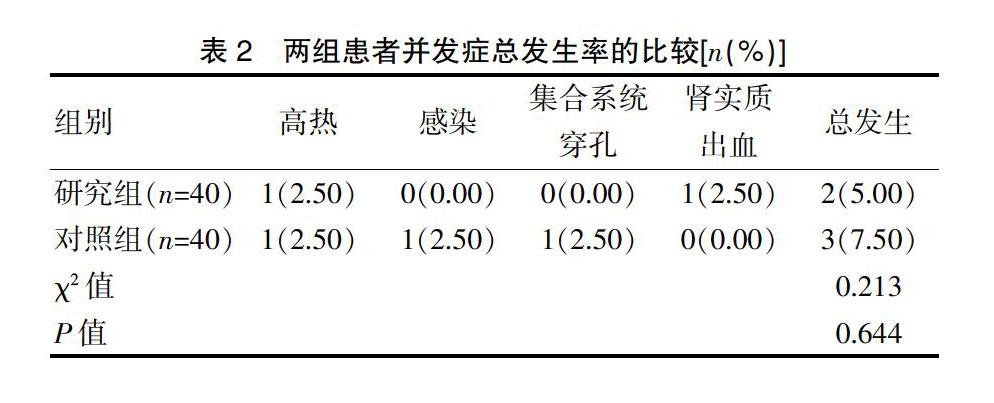微通道经皮肾镜与后腹腔镜治疗嵌顿性输尿管上段结石的临床效果比较
2019-09-19严全华
严全华


[摘要]目的 探讨微通道经皮肾镜与后腹腔镜治疗嵌顿性输尿管上段结石的临床效果。方法 选取2017年1月~2018年3月我院收治的80例嵌顿性输尿管上段结石患者作为研究对象,并按治疗术式的不同将患者分为两组,每组各40例。对照组患者采取后腹腔镜手术取石术进行治疗,研究组患者则采取微通道经皮肾镜进行治疗。比较两组患者的手术时间、术中出血、结石取净率、住院时间、术后疼痛视觉模擬评分(VAS)及并发症发生情况。结果 研究组患者的手术时间、住院时间均短于对照组,术后24 h VAS评分低于对照组,差异有统计学意义(P<0.05),而两组患者的术中出血量比较,差异无统计学意义(P>0.05);研究组患者的结石取净率(100.00%)高于对照组(90.00%),差异有统计学意义(P<0.05);研究组患者的并发症总发生率(5.00%)与对照组(7.50%)比较,差异无统计学意义(P>0.05)。结论 微通道经皮肾镜治疗嵌顿性输尿管上段结石的临床效果肯定,并有操作简单、康复快等优势,在结石取净率方面也有优越性,值得借鉴。
[关键词]结石取净率;微通道经皮肾镜;后腹腔镜;嵌顿性输尿管上段结石
[中图分类号] R693.4 [文献标识码] A [文章编号] 1674-4721(2019)6(a)-0086-03
[Abstract] Objective To investigate the clinical effect of microchannel percutaneous nephroscopy and retroperitoneal laparoscopy in the treatment of incarcerated upper ureteral calculi. Methods A total of 80 cases of incarcerated upper ureteral calculi admitted to our hospital from January 2017 to March 2018 were selected as research objects. The patients were divided into two groups, with 40 cases in each group. The control group was treated by retroperitoneal laparoscopic lithotomy, and the study group was treated by microchannel percutaneous nephroscopy. Operative time, intraoperative bleeding, stone removal rate, length of hospital stay, visual analogue score (VAS) for postoperative pain and complications were compared between the two groups. Results The operation time and hospitalization time of patients in the study group were shorter than those in the control group, and the VAS score of 24 h after surgery was lower than that in the control group, the differences were statistically significant (P<0.05), while there was no significant difference in intraoperative blood loss between the two groups (P>0.05). The stone removal rate in the study group (100.00%) was higher than that in the control group (90.00%), and the difference was statistically significant (P<0.05). The total incidence of complications in the study group (5.00%) was compared with that in the control group (7.50%), and the difference was not statistically significant (P>0.05). Conclusion Microchannel percutaneous nephrolithotomy for the treatment of incarcerated upper ureteral calculi has definite clinical effect, and has the advantages of simple operation, quick recovery and so on. It also has advantages in stone removal rate and is worth learning.
[Key words] Stone clearance rate; Microchannel percutaneous nephroscopy; Retroperitoneal laparoscopy; Incarcerated upper ureteral calculi
